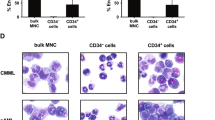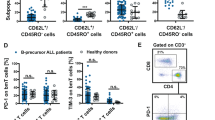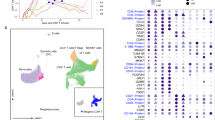Abstract
Leukemia-initiating/repopulating cells (LICs), also named leukemic stem cells, are responsible for propagating human acute leukemia. Although they have been characterized in various leukemias, their role in T-cell acute lymphoblastic leukemia (T-ALL) is unclear. To identify and characterize LICs in T-ALL (T-LIC), we fractionated peripheral blood cell populations from patient samples by flow cytometry into three cell fractions by using two markers: CD34 (a marker of immature cells and LICs) and CD7 (a marker of early T-cell differentiation). We tested these populations in both in vitro culture assays and in vivo for growth and leukemia development in immune-deficient mice. We found LIC activity in CD7+ cells only as CD34+CD7− cells contained normal human progenitors and hematopoietic stem cells that differentiated into T, B lymphoid and myeloid cells. In contrast, CD34+CD7+ cells were enriched in LICs, when compared with CD34−CD7+ cells. These CD34+CD7+ cells also proliferated more upon NOTCH activation than CD34−CD7+ cells and were sensitive to dexamethasone and NOTCH inhibitors. These data show that CD34 and CD7 expression in human T-ALL samples help in discriminating heterogeneous cell populations endowed with different LIC activity, proliferation capacity and responses to drugs.
This is a preview of subscription content, access via your institution
Access options
Subscribe to this journal
Receive 12 print issues and online access
$259.00 per year
only $21.58 per issue
Buy this article
- Purchase on Springer Link
- Instant access to full article PDF
Prices may be subject to local taxes which are calculated during checkout





Similar content being viewed by others
References
De Keersmaecker K, Marynen P, Cools J . Genetic insights in the pathogenesis of T-cell acute lymphoblastic leukemia. Haematologica 2005; 90: 1116–1127.
Ferrando AA, Look AT . Gene expression profiling in T-cell acute lymphoblastic leukemia. Semin Hematol 2003; 40: 274–280.
Blom B, Spits H . Development of human lymphoid cells. Annu Rev Immunol 2006; 24: 287–320.
van Grotel M, van den Heuvel-Eibrink MM, van Wering ER, van Noesel MM, Kamps WA, Veerman AJ et al. CD34 expression is associated with poor survival in pediatric T-cell acute lymphoblastic leukemia. Pediatr Blood Cancer 2008; 51: 737–740.
Dick JE . Stem cell concepts renew cancer research. Blood 2008; 112: 4793–4807.
Reya T, Duncan AW, Ailles L, Domen J, Scherer DC, Willert K et al. A role for Wnt signalling in self-renewal of haematopoietic stem cells. Nature 2003; 423: 409–414.
Bonnet D, Dick JE . Human acute myeloid leukemia is organized as a hierarchy that originates from a primitive hematopoietic cell. Nat Med 1997; 3: 730–737.
Hope KJ, Jin L, Dick JE . Acute myeloid leukemia originates from a hierarchy of leukemic stem cell classes that differ in self-renewal capacity. Nat Immunol 2004; 5: 738–743.
Wang JC, Lapidot T, Cashman JD, Doedens M, Addy L, Sutherland DR et al. High level engraftment of NOD/SCID mice by primitive normal and leukemic hematopoietic cells from patients with chronic myeloid leukemia in chronic phase. Blood 1998; 91: 2406–2414.
Castor A, Nilsson L, Astrand-Grundstrom I, Buitenhuis M, Ramirez C, Anderson K et al. Distinct patterns of hematopoietic stem cell involvement in acute lymphoblastic leukemia. Nat Med 2005; 11: 630–637.
Cox CV, Evely RS, Oakhill A, Pamphilon DH, Goulden NJ, Blair A . Characterization of acute lymphoblastic leukemia progenitor cells. Blood 2004; 104: 2919–2925.
Cox CV, Martin HM, Kearns PR, Virgo P, Evely RS, Blair A . Characterization of a progenitor cell population in childhood T-cell acute lymphoblastic leukemia. Blood 2007; 109: 674–682.
Armstrong F, de la Grange PB, Gerby B, Rouyez MC, Calvo J, Fontenay M et al. NOTCH is a key regulator of human T-cell acute leukemia initiating cell activity. Blood 2009; 113: 1730–1740.
van Dongen JJ, Langerak AW, Bruggemann M, Evans PA, Hummel M, Lavender FL et al. Design and standardization of PCR primers and protocols for detection of clonal immunoglobulin and T-cell receptor gene recombinations in suspect lymphoproliferations: report of the BIOMED-2 Concerted Action BMH4-CT98-3936. Leukemia 2003; 17: 2257–2317.
Weng AP, Ferrando AA, Lee W, Morris JPT, Silverman LB, Sanchez-Irizarry C et al. Activating mutations of NOTCH1 in human T cell acute lymphoblastic leukemia. Science 2004; 306: 269–271.
Krause DS, Fackler MJ, Civin CI, May WS . CD34: structure, biology, and clinical utility. Blood 1996; 87: 1–13.
La Motte-Mohs RN, Herer E, Zuniga-Pflucker JC . Induction of T-cell development from human cord blood hematopoietic stem cells by Delta-like 1 in vitro. Blood 2005; 105: 1431–1439.
Han W, Ye Q, Moore MA . A soluble form of human Delta-like-1 inhibits differentiation of hematopoietic progenitor cells. Blood 2000; 95: 1616–1625.
Bennaceur-Griscelli A, Pondarre C, Schiavon V, Vainchenker W, Coulombel L . Stromal cells retard the differentiation of CD34(+CD38(low/neg) human primitive progenitors exposed to cytokines independent of their mitotic history. Blood 2001; 97: 435–441.
Veerman AJ, Kamps WA, van den Berg H, van den Berg E, Bokkerink JP, Bruin MC et al. Dexamethasone-based therapy for childhood acute lymphoblastic leukaemia: results of the prospective Dutch Childhood Oncology Group (DCOG) protocol ALL-9 (1997-2004). Lancet Oncol 2009; 10: 957–966.
Kong Y, Yoshida S, Saito Y, Doi T, Nagatoshi Y, Fukata M et al. CD34+CD38+CD19+ as well as CD34+CD38-CD19+ cells are leukemia-initiating cells with self-renewal capacity in human B-precursor ALL. Leukemia 2008; 22: 1207–1213.
Meek B, Cloosen S, Borsotti C, Van Elssen CH, Vanderlocht J, Schnijderberg MC et al. In vitro-differentiated T/natural killer-cell progenitors derived from human CD34+ cells mature in the thymus. Blood 2010; 115: 261–264.
Lansdorp PM, Dragowska W, Mayani H . Ontogeny-related changes in proliferative potential of human hematopoietic cells. J Exp Med 1993; 178: 787–791.
McCormack MP, Young LF, Vasudevan S, de Graaf CA, Codrington R, Rabbitts TH et al. The Lmo2 oncogene initiates leukemia in mice by inducing thymocyte self-renewal. Science 2010; 327: 879–883.
Taussig DC, Vargaftig J, Miraki-Moud F, Griessinger E, Sharrock K, Luke T et al. Leukemia-initiating cells from some acute myeloid leukemia patients with mutated nucleophosmin reside in the CD34(−) fraction. Blood 2010; 115: 1976–1984.
Yamazaki H, Nishida H, Iwata S, Dang NH, Morimoto C . CD90 and CD110 correlate with cancer stem cell potentials in human T-acute lymphoblastic leukemia cells. Biochem Biophys Res Commun 2009; 383: 172–177.
Takenaka K, Prasolava TK, Wang JC, Mortin-Toth SM, Khalouei S, Gan OI et al. Polymorphism in Sirpa modulates engraftment of human hematopoietic stem cells. Nat Immunol 2007; 8: 1313–1323.
Majeti R, Chao MP, Alizadeh AA, Pang WW, Jaiswal S, Gibbs Jr KD et al. CD47 is an adverse prognostic factor and therapeutic antibody target on human acute myeloid leukemia stem cells. Cell 2009; 138: 286–299.
Nielsen JS, McNagny KM . Influence of host irradiation on long-term engraftment by CD34-deficient hematopoietic stem cells. Blood 2007; 110: 1076–1077.
Nielsen JS, McNagny KM . Novel functions of the CD34 family. J Cell Sci 2008; 121 (part 22): 3683–3692.
Campana D, van Dongen JJ, Mehta A, Coustan-Smith E, Wolvers-Tettero IL, Ganeshaguru K et al. Stages of T-cell receptor protein expression in T-cell acute lymphoblastic leukemia. Blood 1991; 77: 1546–1554.
Real PJ, Tosello V, Palomero T, Castillo M, Hernando E, de Stanchina E et al. Gamma-secretase inhibitors reverse glucocorticoid resistance in T cell acute lymphoblastic leukemia. Nat Med 2009; 15: 50–58.
Trumpp A, Essers M, Wilson A . Awakening dormant haematopoietic stem cells. Nat Rev Immunol 2010; 10: 201–209.
Chiu PP, Jiang H, Dick JE . Leukemia-initiating cells in human T-lymphoblastic leukemia exhibit glucocorticoid resistance. Blood 2010; 116: 5268–5279.
Palomero T, Sulis ML, Cortina M, Real PJ, Barnes K, Ciofani M et al. Mutational loss of PTEN induces resistance to NOTCH1 inhibition in T-cell leukemia. Nat Med 2007; 13: 1203–1210.
O’Neil J, Grim J, Strack P, Rao S, Tibbitts D, Winter C et al. FBW7 mutations in leukemic cells mediate NOTCH pathway activation and resistance to gamma-secretase inhibitors. J Exp Med 2007; 204: 1813–1824.
Acknowledgements
We acknowledge all the patients and their parents for providing samples for our studies. Cell sorting was performed by the flow cytometry platform of IRCM with the help of N Dechamps and J Baijer (Fontenay-aux-Roses, France). C Joubert, J Tilliet and V Neuville in IRCM provided excellent animal colony care. BG received a fellowship from the Ligue Nationale Contre le Cancer and from the Société Française d’Hématologie. EC is a fellow of Institut du Cancer (INCA). FA was paid by the CreMEC consortium. This work was supported by grants from INSERM, CEA, Université Paris 7, Association Laurette Fugain, INCA and the Cancéropole, Ile de France.
Author information
Authors and Affiliations
Corresponding author
Ethics declarations
Competing interests
The authors declare no conflict of interest.
Additional information
Author contributions
BG, EC, FA, CD, SP and JC performed experiments; BG, EC, PB and FP designed the experiments, analyzed the results and wrote the manuscript; JS and PHR helped with critical experiments and with writing the manuscript; NB, TL, AB, JLP and PB provided patient samples and shared crucial informations.
Supplementary Information accompanies the paper on the Leukemia website
Supplementary information
Rights and permissions
About this article
Cite this article
Gerby, B., Clappier, E., Armstrong, F. et al. Expression of CD34 and CD7 on human T-cell acute lymphoblastic leukemia discriminates functionally heterogeneous cell populations. Leukemia 25, 1249–1258 (2011). https://doi.org/10.1038/leu.2011.93
Received:
Revised:
Accepted:
Published:
Issue Date:
DOI: https://doi.org/10.1038/leu.2011.93
Keywords
This article is cited by
-
Targeting the NOTCH1-MYC-CD44 axis in leukemia-initiating cells in T-ALL
Leukemia (2022)
-
Clonal evolution mechanisms in NT5C2 mutant-relapsed acute lymphoblastic leukaemia
Nature (2018)
-
Baboon envelope pseudotyped lentiviral vectors: a highly efficient new tool to genetically manipulate T-cell acute lymphoblastic leukaemia-initiating cells
Leukemia (2017)
-
Therapeutic antibody targeting of Notch1 in T-acute lymphoblastic leukemia xenografts
Leukemia (2014)
-
Modelling acute leukemias in mice: clonal evolution and the emergence of leukemic stem cells
BMC Proceedings (2013)



